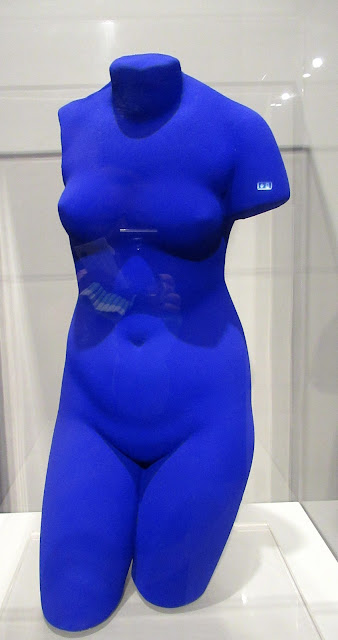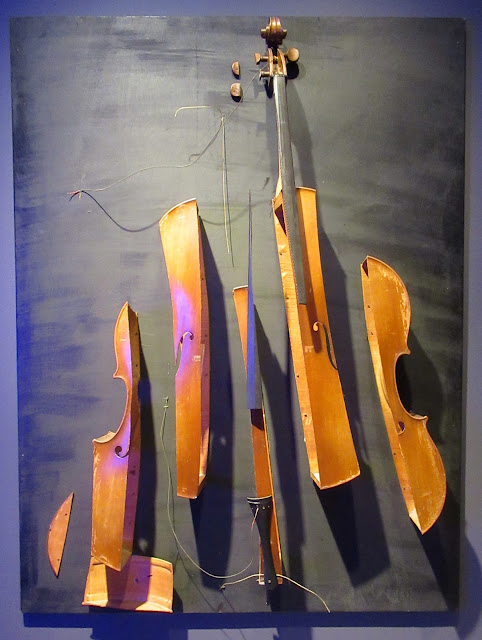New Realism was one of the major artistic movements of the 20th century. It occured at a turning point in history when art ceased being called modern in order to become contemporary. Despite the influence of the movement and all the upheavals it gave rise to, it remains relatively unknown, even though a number of its members are now among the most famous and celebrated artists of the century: Arman, Cesar, Christo, Gerard Deschamps, Francois Dufrene, Raymond Hains, Yves Klein, Martial Raysse, Mimmo Rotella, Niki de Saint Phalle, Daniel Spoerri, Jean Tinguely and Jacques Villegle.
Niki de Saint Phalle, The Bench, 1989
Niki de Saint Phalle/Jean Tinguely, Pallas Athena or the Chariot, 1989
Of all the artist couples who have lived, worked and created together, Tinguely and Saint Phalle were undoubtedly the pair who succeeed in doing it the most freely, authentically and uncompromisingly. In 1979 Saint Phalle began building her Tarot Garden in Tuscany. With the help of Tinguely she chose for her Chariot sculpture, the seventh card in the Tarot, to represent Athena on her cart. The duo repeated the experience in 1989 with the present work that bears both their signatures.
Niki de Saint Phalle, Angel Vase, 1993
Saint Phalle joined the new Realists in 1961. Her colourfulk, curvaceous, imposing, dancing, joyful, triumphant, polyester resin sculptures represent an ode to femininity and to feminism. These Names would proceed to dominate her pictorial world contributing significantly to her international renown.
Jacques Villegle, Untitled, 1961, (torn posters)
Raymond Hains, Diptyque, 1970, (torn posters mounted on sheet metal)
Francois Defrene, Night Livery, the Tapestry, 1965, (torn posters on canvas)
looking closer
Francois Dufrene, Bonnardery, 1960, (torn posters on paper mounted on wood)
Jacques Villegle, The underside of Rue Beaubourg, 1964, (torn posters mounted on canvas)
Christo, Package, 1963, (lacquered brown paper, rope and twine)
Nothing was off-limits for the New Realists. They found material everywhere: in garbage dumps, empty lots, hoardings and billboards, flea markets and other bazaars, supermarkets. Appropriating everyday objects, they followed in the Dada tradition, in particular Marcel Duchamp.
Why obligatorily create from the new? Why afflict to the earth with yet another creation that extracts the requisite raw materials from its entrails? Why deliberately blind ourselves to imagine an ideal world so remote from reality? These are some questions, so timely today, that the New Realists were investigating 60 years prior and that contribute to the movement's actuality. Thanks to these pioneering spirits notions like recycling, repurposing of refuse and even environmental protection were gradually introduced into art. Only Klen cannot be compared to this enselble due to the fact that his process was far removed from the necessity of drawing from pre-existent material to create.
It is furthermore unavoidable to not compare New Realism and Pop Art: the date they were founded, the desire to attack the established order, to find new means of expression, to turn their back on ubiquitous Abstration, the youthful rebellious, irreverent streak, that nevertheless masked a far deeper questioning of society in the 1950s and 1960s - artists on both continents expressed in their art the same concerns and cultivated similar aesthetic idioms.
Even so, the fundamental differences between New Realism and Pop Art extend far beyond the movements' geographic origins. In the face of the nebulous development of the latter, New Realism distinguished itself through its well-defined approach, documentation and communication strategy.
Rarely do we find a Niki de Saint Phalle sculpture featuring a man rather than a woman. Peacefully seated on a bench covered in mosaics, his pet - half-dog and half-goat - at his side, our hero reads a Greek newspaper. The inscriptions were made by the artist Marina Karella, a dear friend of Saint Phalle's who also contributed to the creation of her monumental Tarot Garden in Tuscany.
Niki de Saint Phalle, Snake Chair, 1990 (painted polyester resin)
Niki de Saint Phalle, Snake Chair, 1982 (painted polyester resin)
Saint Phalle said the following about snakes: 'For me snakes represented life itself, an untamable primitive force. By making snakes myself, I was able to transform the fear they inspired in me into joy'. She associated this reptile with the fact that her father raped her at the age of eleven - magnified in her sculptures thus revealing the deeply therapeutic role that art played in her life.
Of Bulgarian descent, Christo arrived in Paris in 1958 after having fled his homeland. He acclimatised quickly to his new host city, but past traumas compelled him to explore the ephemeral, the provisional and the useless. Thus, he set about wrapping all kinds of objects.
Chisto, Wrapped Perambulator, 1962, (perambulator, polythene and rope)
Martial Raysse, Pamela Beach, 1962, (xerographic painting on canvas and painted panel with earring and straw hat)
Gerard Deschamps, Flying Barney, 1985, (mixed media under plexiglass)
Martial Raysse, I really Like this Painting, 1963, (acrylic, metal, plastic on xerography pasted on canvas)
With this work bearing a humorous and ironic title, Raysse intended to collide with the most institutional and established aspects of painting. He deliberately sought out bad taste, imperfection, flaws.
Cesar, Expansion Chair, 1975-76, (polished and patinated bronze)
The Chair successfully combines two practices Cesar was well-versed-in: the use of found objects and expansions. Inherited from his difficult beginnings the first was for him a means of proving that it was no longer relevant to use only the so-called noble materials for sculpture. The second technique chich he had been experimenting with since 1967, celebrates the facility introduced by synthetic materials, in particular polyurethane that is so light and malleable it readily assumes any form desired.
Yves Klein, Untitled Blue Monochrome (IKB 233), 1957, (pure pigment and synthetic resin)
For Klein the monochrome adventure was much more than just a pictorial experience. He, who went by the moniker 'Yves the Monochrome', lived his compositions as a metaphysical practice leading him towards the purity and liberty he so longed for. Blue had pride of place in Klein's monochrome adventure because, according to him, it was the only colour that had no dimension, thus allowed for the passage from the material to the immaterial. To do this the painter invented his trademark ultramarine pigment, International Klein Blue, or IKB.
Yves Klein, The Winged Victory of Samothrace, 1962, (pure pigment and synthetic resin on plaster)
Yves Klein, Blue Venus, 1962, (dry pigment and synthetic resin on plaster)
In June 1958 Klein presented, for the first time, a work executed by a 'living brush'. A female nude model daubed herself in blue paint, then imprinted traces of her body on a sheet of white paper following the artist's directions. Works created in this manner were dubbed Anthropometries by Pierre Restany.
Yves Klein, Untitled Fire Painting, (F6), 1961, (burnt cardboard on panel)
After having worked the void, air, water and the human body, Klein was granted authorisation from the Central Research Laboratory of the National Gasworks of France to conduct his first series of Fire Paintings in March 1961. He passed a blowtorch over supports sprayed with water that blackened differently depending on where the flame made contact. This marked a turning point in Klein's pictorial quest: 'Now I want to go beyond art, beyond sensitivity, beyond Life'.
Cesar, Thumb, 1980, (polished bronze)
In 1965 the Galerie Claude Bernard invited Cesar to participate in a group exhibition on the subject of 'The Hand'. Having just recently discovered the pantograph, an instrument that allows for the reproduction of an identical sculpture and to modify its scale, he decided to duplicate his own thumb. Thus began the Empreintes series. The works presented here represent the thumb of Elise Goulandris, who was a close friend of Cesar's along with her husband Basil.
Cesar, Breast, 1966-67, (lacquered polyurethene resin)
Cesar, Breast, 1966-67, (lacquered polyurethene resin)
From the Empreintes series, the Breast was cast from the bust of a dancer who performed at the Crazy Horse cabaret in Paris. Like the Thumb, the Breast would appear in a variety of dimensions and materials, even enlarged up to 50.6 metres for the steel version.
Raymond Hains, Saffa, 1971, (cut painted wood under plexiglass)
Arman, Major Chord, 1962, (sliced cello on wooden panel)





































No comments:
Post a Comment